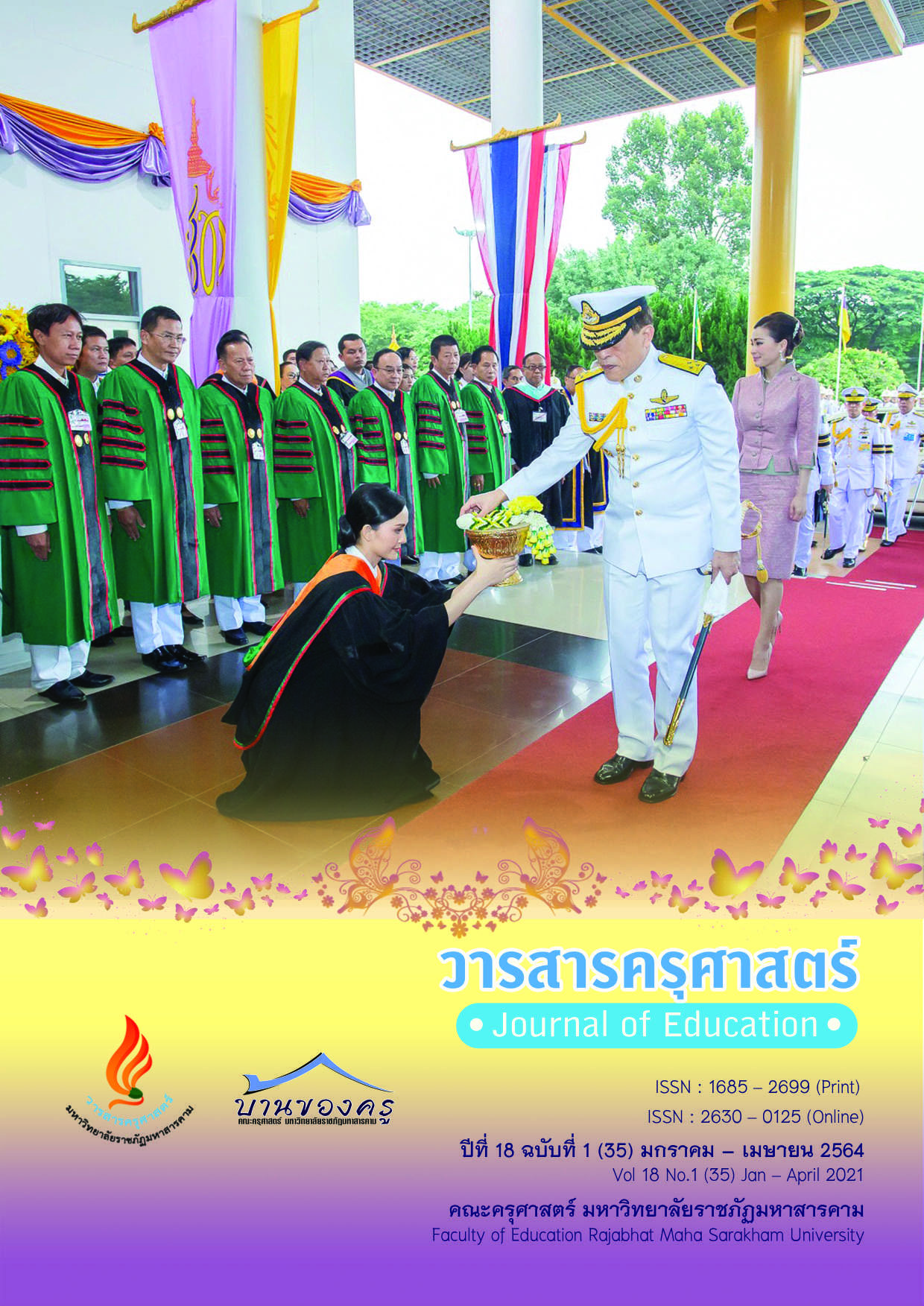The Model for Developing Desirable Characteristics of Primary Students’ Sufficiency, Under the Roi Et Primary Educational Service Area Office 1
Main Article Content
Abstract
The objectives of the research were to 1) study the components and indicators of desirable characteristics of primary students’ sufficiency under the Roi Et primary educational service area office 1. 2) design the model for developing desirable characteristics of primary students’ sufficiency, and 3) study the result of using the model for developing desirable characteristics of primary students’ sufficiency. The target groups were 9 experts for evaluating the model and 40 students for the experiment the model, Obtained by purposive sampling. Research tool was questionnaire. The data was analyzed by quantitative and qualitative. The statistic used percentage, mean and standard deviation.
The research revealed that: 1) Components and indicators of desirable characteristics of primary students’ sufficiency had 6 main components and 34 indicators, evaluation of desirable characteristics overall at the highest level. 2) The model for developing desirable characteristics was composed 7 main components as follows: Background of rational criterion, The objective of the model, The component of the model, The indicator of desirable characteristics of sufficiency, The way to develop desirable characteristics of sufficiency, Learning media and Measurement and evaluation. The evaluation of the model overall was appropriate and possible at high level. and 3) The result of using the model, The pre-development in overall was at moderate level, post-development in overall was at highest level. The satisfaction was using the model overall at the highest level.
Article Details
ข้อกำหนดเบื้องต้นที่ผู้นิพนธ์(ผู้ส่งบทความ) ควรทราบ
1. ผู้นิพนธ์ที่ประสงค์จะลงตีพิมพ์บทความกับวารสาร ตั้งแต่เดือนมกราคม 2563 เป็นต้นไป ให้ใช้รูปแบบใหม่ (Template 2563) โดยสามารถดูตัวอย่างได้ที่เมนู GUIDELINES
2. จะตีพิมพ์และเผยแพร่ได้ ต้องผ่านการประเมินจากผู้ทรงคุณวุฒิ (Peer Review)
3. การประเมินบทความโดยผู้ทรงคุณวุฒิ (Peer Review) เป็นแบบ Double Blind
4. การอ้างอิงบทความใช้หลักเกณฑ์ APA (American Psychological Association) คลิก
5. บทความถูกปฏิเสธการตีพิมพ์ ไม่ผ่านการประเมิน ผู้นิพนธ์ขอยกเลิกเองหรือชำระเงินก่อนได้รับการอนุมัติ ทางวารสารไม่มีนโยบายการคืนเงิน
References
กระทรวงศึกษาธิการ. (2551). หลักสูตรแกนกลางการศึกษาขั้นพื้นฐาน พุทธศักราช 2551. กรมวิชาการ.
กระทรวงศึกษาธิการ. (2553). นโยบายวิสัยทัศน์พันธกิจ. กรมวิชาการ.
คณะศึกษาศาสตร์ มหาวิทยาลัยขอนแก่น. (2551). หลักการและแนวปฏิบัติในการจัดคุณลักษณะศึกษาเพื่อพัฒนาคุณลักษณะที่ดีของเด็กและเยาวชน. มหาวิทยาลัยขอนแก่น.
นพรัตน์ อิทร์พันธ์. (2561). รูปแบบการพัฒนาคุณลักษณะอันพึงประสงค์ของนักเรียนโรงเรียนไทยวัฒนาประชารัฐ อำเภอสีคิ้ว จังหวัดนครราชสีมา. [วิทยานิพนธ์ปริญญามหาบัณฑิต ไม่ได้ตีพิมพ์]. มหาวิทยาลัยราชภัฏนครราชสีมา.
พรรณพิศ จันทสุวรรณ และนิธิพัฒน์ เมฆขจร. (2559). ผลการใช้ชุดกิจกรรมแนะแนวที่มีต่อคุณลักษณะอันพึงประสงค์ด้านอยู่อย่างพอเพียง ของนักเรียนชั้นมัธยมศึกษาปี ที่ 1 โรงเรียนวัดหูแร่ จังหวัดสงขลา. วารสารศึกษาศาสตร์ มหาวิทยาลัยสุโขทัยธรรมาธิราช. 9(2), 204-213.
เพิ่มศักดิ เพิ่มประยูร. (2552). คุณลักษณะที่พึงประสงค์ของผู้บริหารสถานศึกษาตามความคิดเห็นของผู้บริหารและครูผู้สอนสังกัดสำนักงานเขตพื้นที่การศึกษาลพบุรี. [วิทยานิพนธ์ปริญญามหาบัณฑิต ไม่ได้ตีพิมพ์]. มหาวิทยาลัยราชภัฏเทพสตรี.
วชิรดล คำศิริรักษ์. (2559). การพัฒนารูปแบบกิจกรรมเสริมสร้างคุณลักษณะอันพึงประสงค์ สำหรับนักเรียนชั้นมัธยมศึกษาตอนต้น. [วิทยานิพนธ์ปริญญาดุษฎีบัณฑิต ไม่ได้ตีพิมพ์]. มหาวิทยาลัยราชภัฏสกลนคร.
สำนักงานคณะกรรมการการศึกษาขั้นพื้นฐาน. (2550). แนวทางการกระจายอำนาจการบริหารและการจัดการศึกษาให้คณะกรรมการ สำนักงานเขตพื้นที่การศึกษาและสถานศึกษาตามกฎกระทรวงกำหนดหลักเกณฑ์และวิธีการกระจายอำนาจบริหารและจัดการศึกษา พ.ศ. 2550. สำนักงานคณะกรรมการการศึกษาขั้นพื้นฐาน.
เสาวลักษณ์ มาพร. (2551). ความพร้อมในการนำหลักปรัชญาเศรษฐกิจพอเพียงไปจัดการศึกษาในสถานศึกษาสังกัดสำนักงานเขตพื้นที่การศึกษาขอนแก่นเขต 1. [วิทยานิพนธ์ปริญญามหาบัณฑิต ไม่ได้ตีพิมพ์]. มหาวิทยาลัยขอนแก่น.
Likert, Rensis. (1967). The Method of Constructing and Attitude Scale. Wiley & Son.
Ministry of Education. (2008). Basic Education Curriculum B.E. 2544 (A.D.2001). Kurusapa Ladprao Publishing.


